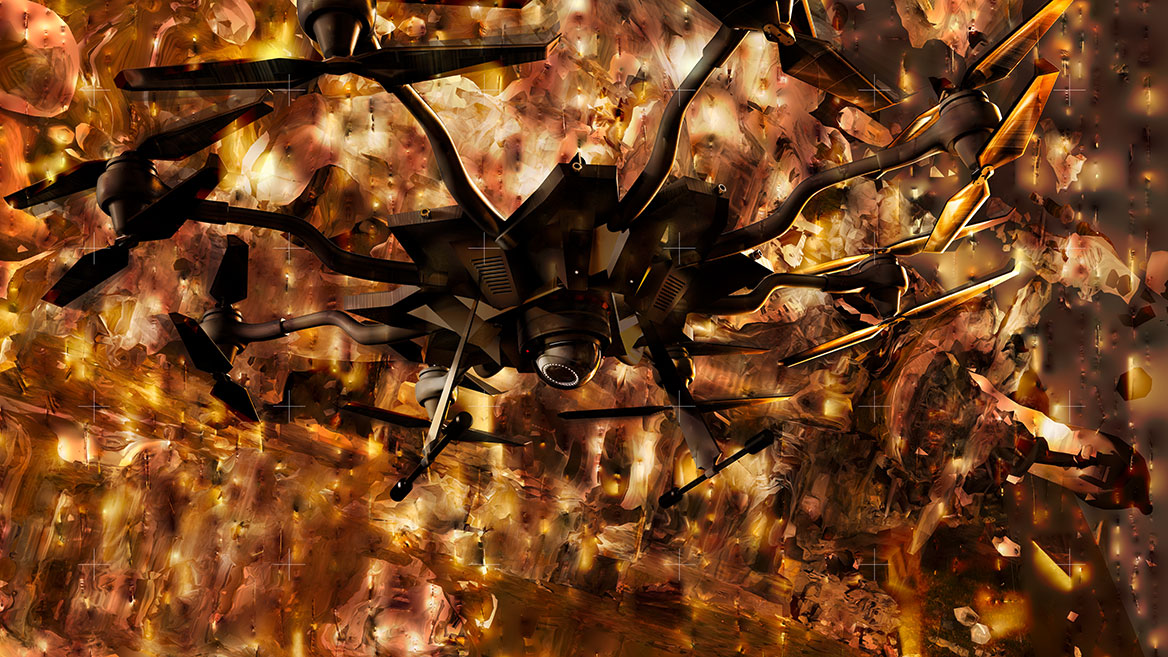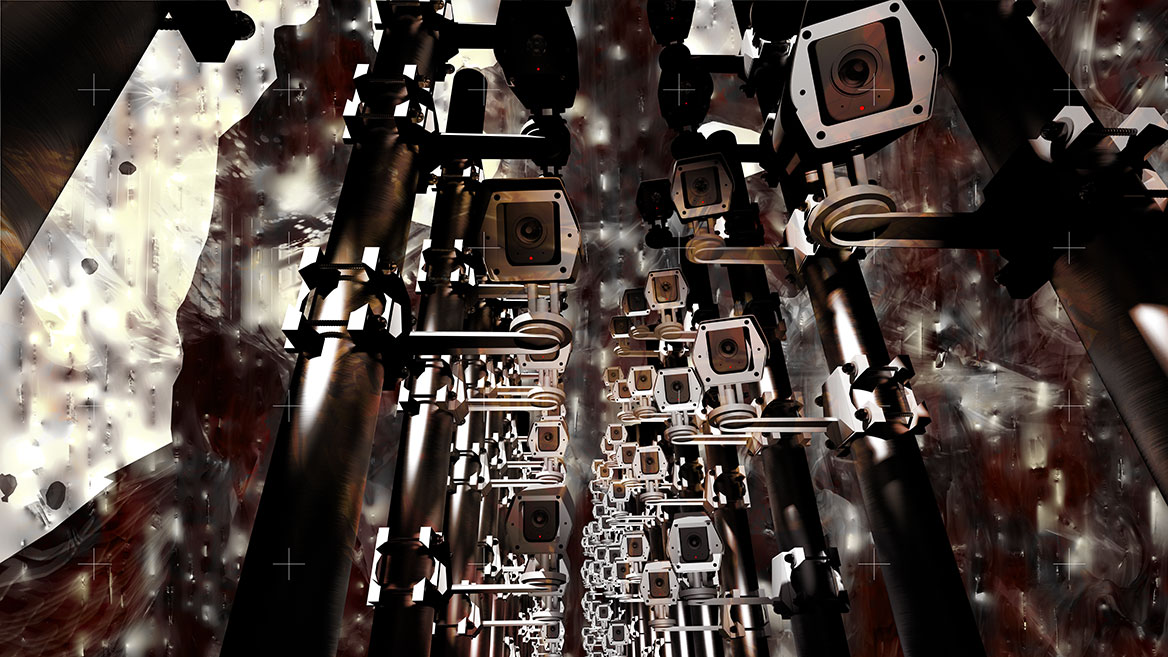
The present work is protected by copyright in all its parts.
© 2021 by Heinz Hermann Maria Hoppe.
All rights reserved.



Comment
Author: Heinz Hermann Maria Hoppe
At the workplace, in the department store, in front of the town hall and above the traffic intersections, lenses are aimed at us. Surveillance technology is as coveted by intelligence agencies as it is by allotment garden owners. The polished lenses of the tinny spies are sharp-eyed, like eagle eyes. Sensors and algorithms are modern answers to our fears about the loss of security and order. Technology is supposed to fulfill our dream of purity and transparency. “Why shouldn’t we? After all, we have nothing to hide.” We voluntarily grant the anonymous overseers behind the monitors deep insights into our private sphere - just for our own safety?
Terrorism and crime catapult suffering and fear to the world. Without question, ‘sensitive areas’ need surveillance facilities. But the ratio of ‘fear of real dangers’ to ‘surveillance measures’ seems to be out of control. For the industry our ‘demand for security’ brings rich revenue growth. Free societies are confronted with more and more surveillance cameras in public places, visible expressions of distrust towards everyone. Surveillance technology shifts power relations in favor of the ‘sighted’ and creates surveillance pressure. The ‘big brothers’ of this world not only spy on our hardships and dangers. They also look deep into our habits, behaviors and wallets. After all, the same people who are supposed to be protected are also consumers. The “security” argument appears almost lavishly in argumentation, in advertising and propaganda alike. “Security” can, almost always, be sold.
Voluntarily giving up civil liberties does not lead to more security and only temporarily to happiness. ‘Seamless persecution’ would be an obstacle to freedom. The belief in gaining security in exchange for ‘transparency’ is naïve. Tracked at every turn, mobile societies are not safer and freer, but trapped.
In the panopticon of power, the knowledge of ‘self-learning algorithms’ for ‘biometric facial recognition’ and ‘movement pattern analysis’ is interesting. This know-how helps to curtail people’s freedoms and ways of life. The fundamental suspicion of one’s own people is typical of surveillance states. Controls and social ostracism follow propaganda arguing for ‘more security for society’. Totalitarian power goes hand in hand with censorship, the creation of feelings of guilt, intimidation and agitation. The rest is taken care of by an infiltrated, compliant majority at some point, when the structures have been practiced down to the lowest levels of society. “Then even one’s own children turn one in.” Sorted into social groups, marginalized or imprisoned, dissenters, stigmatized as undesirable ‘elements’, end up in ghettos or behind bars. Coordinated surveillance measures are a prerequisite for one-sided supremacy structures. The greed for data goes hand in hand with the greed for power; data protection for citizens is no longer of interest.
Surveillance technology is a ‘double-edged sword’, but it always remains a sword. It can protect us from crime or violate and rob our privacy. ‘Transparency’ and ‘security’ hold up as arguments for implementing surveillance, operated by inconspicuous apparatus and by sophisticated software. The greatest power would go to those who could read people’s minds. Advances in combining automated real-time evaluations of pupil movements, facial expressions and body postures are close to making this nightmare a reality. Big Data and Artificial Intelligence are the ‘dream team’ for ‘social transparency’ programs.
‘Security thinking’ is therefore in tension with true civil liberties and libertarian thinking. Between necessary monitoring measures for ‘operational secrecy’ and the ‘rights to personal freedoms’ of employees, the pendulum often swings to the disadvantage of employees. 360-degree-monitored employees, like ‘glass patients’, are unfree. They are forced to ‘put a smile on their faces’. Where authorities and bosses can ‘spy’ unnoticed at any time, we are almost in the middle of an Orwell movie. The recording of activities, websites visited, programs used, and the linking of these data, make basically everyone suspicious who can be assigned to any theoretical pattern. The possibility of recognizing abnormal behavior on the one hand leads to adapted and actor-like behavior on the other.
Centralized data storage poses risks compared to decentralized systems. ‘Electronic wallets’ for citizens may seem efficient, but they require an overview and allocation of the exact characteristics and data of a person. For this reason, network activists are in favor of ensuring that no single body has a full overview of citizens, so that comprehensive data on a person cannot be linked together and digital sovereignty (‘Self-Sovereign Identity/SSI’) is preserved. ‘ePassports’ with biometric data, ‘online banking’, ‘RFID technology’, body scanners, ‘eavesdropping’ and ‘hacking’, the transmission of ‘airline passenger data’, ‘online searches’, ‘DNA databases’ and especially the linking and networking of data, pose huge challenges for data protection. Who knows if in the future our iris won’t be used for automatic identification, the same iris that can be seen on the ‘selfies’ we post?
Our devotion to social media ignores the risks that corporate monopolies and totalitarian systems take advantage of. “He who has nothing to hide has nothing to fear” is wrongheaded. “Those who would give up essential liberty, to purchase a little temporary safety, deserve neither liberty nor safety.” by Benjamin Franklin is accurate. Where everyone is always watching each other, resentment is the seed for denunciation, bashing and stabbing. Freedom of expression does not work with ‘suspicious glances’ at one’s back and ‘walls that have ears’. Latent pressure to conform leads to frightened fellow human beings who do not dare to open their mouths, even though the cameras were supposedly intended to allay their fears.
There is no doubt that surveillance technology deters criminals. But surveillance is also a trade in fears. It creates a backdrop that reminds us that we should constantly be worried. We’re not even supposed to know when we’re being watched, so we never feel unobserved. This is supposed to provide order, but it also stirs up constant distrust and fear of others. At the same time, we want places where we can be unconcerned, places of real order and sincere transparency, which do not hide any nasty surprises, but radiate calm and peace. How can an environment be ‘clean’ that signals latent danger through constantly focusing lenses?
Wouldn’t our emanation of more trust in our fellow human beings, on balance, create more security than an atmosphere of mistrust and general suspicion? Is the idea of societies in which the other person is first assumed to have good, rather than bad, intentions really naïve? Why don’t we develop apparatuses to promote trust-building measures in addition to surveillance cameras? “For the image of man that we hold to be true becomes itself a factor in our lives. It determines the ways in which we deal with ourselves and with fellow human beings, the mood of life and the choice of tasks.” (Karl Jaspers). What is naïve about this thought?
Recommended literature: Baumann, Zygmunt and Lyon, David: Liquid Surveillance. A Conversation. John Wiles& Sons, 2012.